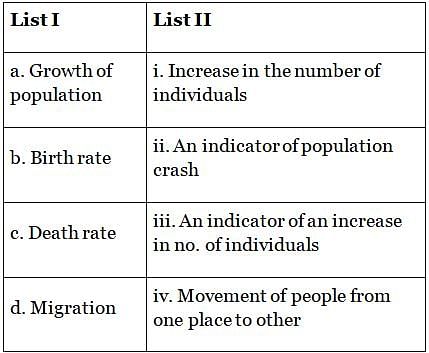AP TET Paper 2 Mock Test - 9 (Social Science) - AP TET MCQ
30 Questions MCQ Test - AP TET Paper 2 Mock Test - 9 (Social Science)
Which of the following could be an end stage of a child possessing bodily-kinesthetic intelligence?
As per the Right to Education Act 2009, which of the following statements is correct?
Continuous and comprehensive evaluation includes:
School-based assessment was introduced to:
Which type of learning mainly influences personality of the child?
What type of questions should the teacher ask to identify creative children?
दिए गए गद्यांश को ध्यानपूर्वक पढ़िए तथा पूछे गए प्रश्न के उत्तर के लिए सबसे उपयुक्त विकल्प का चयन कीजिए।
राजभाषा का अर्थ राजा या राज्य की भाषा है। वह भाषा जिसमें शासक या शासन का काम होता है। राष्ट्रभाषा वह है जिसका व्यवहार राष्ट्र के सामान्य जन करते है। राजभाषा का क्षेत्र सीमित होता है। राष्ट्र भाषा सारे देश की संपर्क भाषा है। राष्ट्रभाषा के साथ जनता का भावात्मक लगाव रहता है क्योंकि उसके साथ जनसाधारण की सांस्कृतिक परम्पराएँ जुड़ी रहती हैं। राजभाषा के प्रति वैसा सम्मान हो तो सकता है, लेकिन नहीं भी हो सकता है, क्योंकि वह अपने देश की भी हो सकती है। किसी गैर देश से आये शासक की भी हो सकती है। लोकतांत्रिक व्यवस्था में आज हिन्दी राजभाषा के रूप में ही विराजित है। 14 सितंबर, 1949 ई. को भारत के संविधान में हिन्दी को मान्यता प्रदान की गई है। संविधान की अनुच्छेद 120 के अनुसार संसद का कार्य हिन्दी में या अंग्रेजी में किया जाता है। अनुच्छेद 210 के अंतर्गत राज्यों के विधानमंडलों का कार्य अपने-अपने राज्य की राजभाषा या हिन्दी में या अंग्रेजी में किया जा सकता है। 343 के अनुसार संघ की राजभाषा हिन्दी और लिपि देवनागरी होगी। इस भाषा का प्रसार तथा प्रचार के लिए महात्मा गाँधी का योगदान रहा है। अनुच्छेद 344 में राष्ट्रपति को शासकीय कार्य में हिन्दी भाषा का प्रयोग अधिक करने के लिए कहा गया है।
Q. राजा का पर्यायवाची नहीं है ____।
मौन वाचन का प्रकार नहीं है
(i) समवेत वाचन
(ii) द्रुत वाचन
(iii) वैयक्तिक वाचन
(iv) अनुकरण वाचन
भाषा कौशलों में कुशलता लाने के लिए आवश्यक है-
निर्देश : नीचे दिए गए पद्यांश को ध्यानपूर्वक पढ़कर सबसे सटीक विकल्प का चयन कीजिए-
पालने के सिरहाने गायी जाने वाली लोरियों से लेकर
रेडियो से आने वाले समाचारों तक
हर जगह छिपे हुए असत्य पर विजय पाना
चाहे वह असत्य हृदय में हो या किताबों में
या शोर-गुल भरी सड़कों पर
कितना कल्पनातीत आनंद है ज्ञान में
यह जान लेने में
कि समय के कदम अनिवार्य रूप से किधर बढ़ते रहेंगे
और अब भविष्य में क्या आनेवाला है।
Q. कवि के अनुसार महत्वपूर्ण है -
In a diverse classroom, learners find it difficult to speak and write good English and often lapse into their mother-tongue because
Choose an appropriate and meaningful written assignment in Social Science from the following:
In order to understand the role of various issues during an election, which of the following would you most likely ask your students?
Tawa Matsya Sangh is fighting for which of the following issue?
The area of a rectangle is 'A' cm2 and length is cm. Its perimeter (in cm) is
The situation of depletion of ozone layer is referred to as ozone hole if the ozone level decreases below
Where was the Hindustan Socialist Republican Association (HSRA) founded?
Assertion (A): The British wanted tribal groups or jhum cultivators to settle down and become peasant cultivators.
Reasoning (R): Settled peasants were easier to control and administer than people who were always on the move.
Choose the correct option
The temperature in 'Visakhapatnam' is 40ºC. The temperature on Mt. Everest at the height of 8,848 metres will be
In Social Science, the recent NCF position paper on examination reforms emphasises
“Explain the concept of Forests” – this question helps us to know the achievement of which of the following objectives?
While discussing gender roles in the classroom, you would assert that
A social science teacher takes students to visit the Panchayat office the learning about Panchayat. In this situation, which learning strategy is adopted by the teacher?
Which one of the following is a disadvantage of Inquiry-based Learning?
Consider the following statements regarding Population:
A. The way in which people are spread across the earth surface is known as the pattern of population distribution.
B. More than 90 per cent of the world’s population lives in about 30 percent of the land surface.
C. The distribution of population in the world is extremely uneven.
Choose the correct option?
In India, the Munda Tribe lived in the region of
How can a social science teacher effectively and experientially transact the concept of sustainable development among students?
Which of the following are the largest and smallest continents of the world?



















